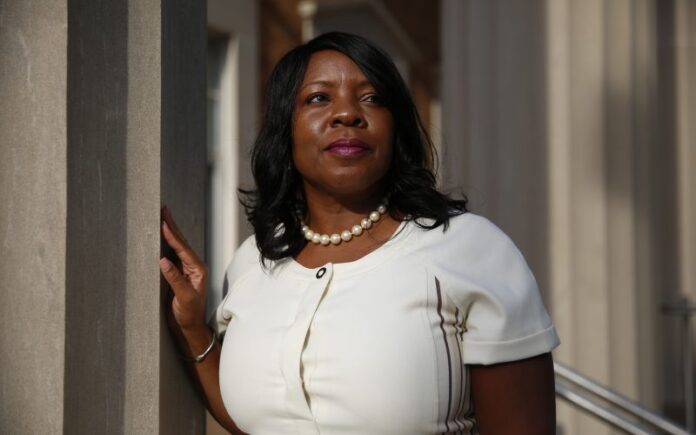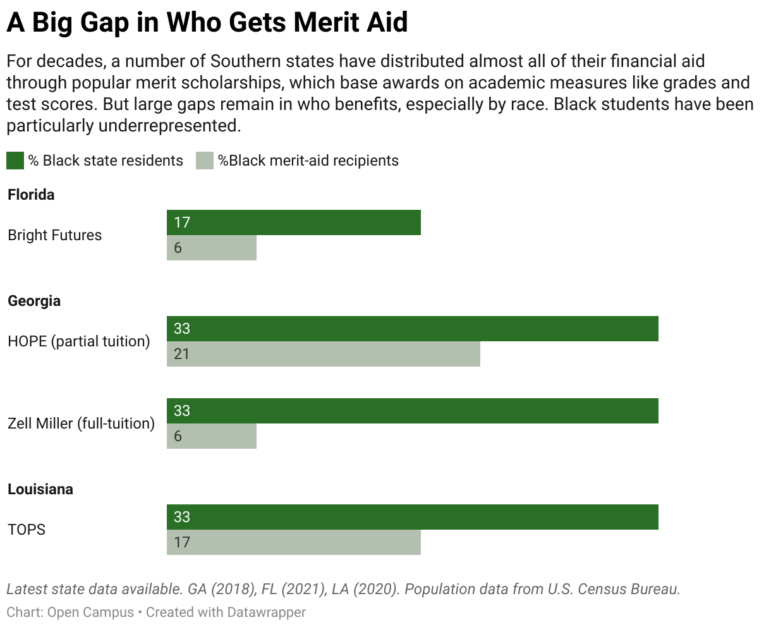
Need help paying for college? There’s good news, states across the South tell their students. You can earn it.
“The Bright Futures Scholarship Program offers opportunity and prosperity for all Florida families!” the department of education there tweeted this spring.
The message seems simple: Anyone can get most, or even all, of their tuition paid through the state’s signature program. Students just have to get the right grades and standardized test scores.
Bright Futures has loomed large, then, in the work of people like Sherry Paramore. As the president of Elevate Orlando, a nonprofit group, she helped Florida high school students get to college. Every September, Paramore would go over finances, walking through the types of aid. She’d work with tutors to help her students improve their grades. She connected them with mentors to plan their careers.
To Paramore, they’re exactly the kinds of students a state scholarship should help. They worked hard and got accepted to college. But when it came to Bright Futures, there was a mismatch.
Over three years Paramore worked with nearly 200 students. Many were the first in their families to attend college; most were Black. But they struggled with the standardized tests. So in the end, how many qualified for a Bright Futures scholarship — the ticket Florida created to educational opportunity? Not a single one.
An appeal to the middle class
A generation ago, politicians across the South created scholarships like Bright Futures. Pivoting from the long-standing practice of giving out money for college based on family income, they turned to measures of academic achievement.
First in Georgia, then Florida, Louisiana, South Carolina, and elsewhere, lawmakers talked about keeping the “best and brightest” at home and doing more to help the middle class as the price of college escalated. Many of the programs were funded by state lotteries, so proponents could pitch the aid to taxpayers as if they were getting something for nothing.
Not surprisingly, the policies proved politically popular, especially among white, middle-class residents. They were, after all, some of the biggest beneficiaries — and still are.
State programs, of course, make up only one part of a student’s financial aid picture, with federal Pell Grants, college discounts, and loans helping families pay. But many of these state merit programs are especially generous, often covering full tuition or close to it.
And 30 years later, large gaps remain in who they benefit, especially by race. The rhetoric from these programs’ advocates has been that they expand opportunity equally, but the reality is that they have not.
In Louisiana, nearly three-quarters of recipients of the Taylor Opportunity Program for Students (known as TOPS) are white. Only about half of first-time entering freshmen in the state are.
In Georgia, Black and Native American students remain the least likely to receive the state’s merit scholarships, and Black students are especially underrepresented among those whose full tuition is covered.
And in Florida, where 17 percent of the population is Black, no more than 7 percent of Bright Futures recipients have been in any year since the program started.
The rhetoric of opportunity
Race was part of the conversation from the beginning.
When Zell Miller proposed the HOPE scholarship in Georgia, he touted it as “the most all-inclusive scholarship program to be found in any of the 50 states.” What the governor was saying was that it would also help white, middle-class voters — not just the people those key political constituents might associate with government aid.
HOPE would be “not only for those who are minorities or who come from lower-income families,” the Southern Democrat made a point to say in his 1992 State of the State speech, “but also those middle-income families who are devastated with the cost of education and training beyond high school.”
Miller’s speech was laced with rhetoric about how the scholarship would reward “deserving students.” The idea that this money would be earned was key to its popularity.
“Poor, Black people are buying tickets and rich, white kids are getting the benefits.”
Jonathan Cohen, author of a book about state lotteries
The same is true today. Last fall, Georgia’s current governor, Brian Kemp, a Republican, celebrated a milestone for HOPE: It had helped more than 2 million Georgians go to college, through a total of $12.6 billion in awards. HOPE, the governor said, was a “game-changer” for Georgia.
As more high-achieving students stayed in the state, the scholarship has improved the reputations of state universities like Georgia Tech and the University of Georgia. Merit-aid programs have had similar effects elsewhere, as in Florida, where places like the University of Florida and Florida State have risen in rankings, too.
But the scholarship has done more to influence where students go to college than who actually goes, said Christopher Cornwell, head of the economics department at the University of Georgia. And HOPE has not helped all residents equally, disproportionately aiding white and wealthier students.
Asked about those disparate benefits, the governor’s press secretary sidestepped the issue of race. “HOPE impacts Georgia students based on individual output and merit,” Katie Byrd said in an email. “It is accessible to all Georgians equally.”
That kind of thinking ignores the context of history, says Jennifer Lee, a policy analyst at the Georgia Budget & Policy Institute. Many years of discrimination in housing, employment, and the financial sector, she says, have resulted in huge wealth gaps in Georgia and across the country.
One of the biggest gaps Lee found in her research was in who received a full-tuition scholarship.
Just over a decade ago lawmakers, facing budget pressures, divided the HOPE scholarship into two. The Zell Miller Scholarship covers full tuition for students with at least a 3.7 GPA and a 1200 SAT, or 26 ACT, score. (HOPE has lower requirements and lower award amounts.)
Only 6 percent of the Zell Miller recipients are Black and 70 percent are white, Lee found. Among all in-state undergraduates, 29 percent are Black and 49 percent are white.
On top of disparities in who gets the aid, there are also inequities in who pays for merit scholarships like those in Georgia and Florida that are primarily funded by state lotteries.
The bulk of lottery tickets are bought by people who are lower income, have lower levels of education, and are nonwhite, says Jonathan Cohen, a program officer at the American Academy of Arts and Sciences and the author of a book about state lotteries.
“Poor, Black people are buying tickets and rich, white kids are getting the benefits,” Cohen says.
To illustrate the disparities he likes to cite the “HOPE Mobile,” the phenomenon where white, suburban parents took money they had saved for tuition and used it to buy cars for their children, now attending state colleges for next to nothing. HOPE was directly responsible for rising car sales, Cohen says one study found, in the richest 25 percent of Georgia counties in 1994 and 1995.
A message about worth
Ask college students how states should give out financial aid and most say it should be based more on students’ financial need than on academic performance.
Seventy-one percent of the 500 college students surveyed this year by College Pulse, an online survey and analytics company, for Open Campus said states should focus more on financial need. Just 17 percent said states should instead focus more on academic performance. The rest said they weren’t sure.
Their responses differed significantly by race. Among nonwhite students, even more — 80 percent — said states should focus on financial need. That compares with 65 percent of white students.
“Out of everything, your whole experience and all the hard work that you did, it is almost like it doesn’t matter if you can’t pass this test.”
Samantha Guillaume, a junior at Rollins College
Beyond shifting who the state is helping to pay for college, merit scholarships send a message to students. And that’s made some of them question their place.
In Georgia, Aboubacar Barrie learned about the HOPE scholarship his senior year of high school. He met the GPA requirement and is a HOPE scholar but his test scores weren’t high enough to qualify for the full tuition, Zell Miller scholarship.
Barrie, who is a Black, first-generation college student, was intimidated. “I started questioning myself: Am I really going to get this or am I worthy enough?”
Achieve Atlanta, an education advocacy organization, offered him a need-based scholarship to help him bridge the gap. He’s now a business major at Georgia Tech.
In Florida, Samantha Guillaume spent weekends taking practice test after practice test for the SAT. Still, Guillaume, who is Black, wasn’t able to close the 30-point gap between her score and the requirement for Bright Futures.
Even with college acceptance letters — she’s now a junior at Rollins College — Guillaume said not qualifying for Bright Futures felt dismissive. “Out of everything, your whole experience and all the hard work that you did, it is almost like it doesn’t matter if you can’t pass this test.”
The millionaire complication
In some states, like Louisiana, leaders are starting to reconsider how they factor income into aid decisions.
Last fall, a new data point about TOPS, that state’s merit scholarship, made headlines: Over the past decade Louisiana has paid for more than 11,000 students whose parents are millionaires to attend college.
Kim Hunter Reed, the state’s commissioner of higher education, said the connection between family income and TOPS is hard to ignore. “That is the biggest challenge we face in higher education,” she said, “the goal of decoupling students’ success and family income.”
When it comes to providing aid, she says she doesn’t see it as an either-or situation between merit and need-based programs. Louisiana, she says, needs both. And right now, Reed adds, the state needs “a huge infusion” on the need-based side.
The state increased funding last year for its need-based program, known as GO Grants, by $11 million, the largest base increase in its history. This year, the Board of Regents requested $10 million more.
Still, significantly more money is awarded through merit aid. The state is spending $41 million on GO Grants, but more than eight times as much on TOPS, a total of $331 million last year.
And in that program, too, there are racial disparities in who receives the merit aid. Close to three-quarters of TOPS recipients in 2019-20 were white, while just 17 percent were Black, in a state where about one-third of residents are.
“That is the biggest challenge we face in higher education, the goal of decoupling students’ success and family income.”
Kim Hunter Reed, Louisiana’s commissioner of higher education
Advocates of TOPS say it has benefited the state in a number of ways.
The program incentivizes students to be academically prepared for college, says Sujuan Boutté, executive director of the Louisiana Office of Student Financial Assistance. And TOPS scholars graduate from college at higher rates: In 2019, 36 percent of TOPS scholars graduated within four years compared with 18 percent of their peers.
“Regardless of how much money a student is given to attend college, if that student is not academically prepared to succeed,” Boutté says, “then how much of a service have you done that student?”
When it comes to racial gaps, Boutté says TOPS isn’t the issue. The debate needs to start earlier, focused on larger systemic barriers. Students from underrepresented backgrounds need better advising and academic support, she says. They should get more opportunities to visit college campuses, and their parents need more support, too.
Jan Moller, executive director of the Louisiana Budget Project, a nonprofit group that advocates for policies that support low-income families, acknowledges that big societal problems cannot all be solved by changing a financial aid program. But it would be one way to help.
“We can’t lay all of the problems and all of the inequities that are baked into Louisiana’s social and economic structure at the feet of the TOPS program,” Moller said. “But certainly we can use college and higher education, when done right, to be a tremendous equalizer.”
It’s become baked in
Most states don’t distribute their aid this way. Thirty of them spend less than 10 percent on non-need based grant aid. That makes these Southern states, where 90 percent or more of the financial aid is given regardless of need, stand out even more.
Over the years, lawmakers have debated changing the merit scholarships.
Sometimes, that’s made disparities worse. Florida increased requirements, including standardized test scores, for Bright Futures a decade ago when it began to worry about having enough money for the program. The number of Black and Hispanic students who qualified dropped disproportionately.
There have been moves to increase need-based aid, such as Reed’s advocacy in Louisiana. Georgia policymakers authorized a broad need-based aid program back in 2018, but they haven’t yet spent any money on the grants.
After three decades, the idea of awarding aid based on popular ideas of merit has become baked in. The rhetoric of rewarding achievement is hard to fight. How, after all, can you be against opportunity?
And now, some of the same debates are popping up in another Southern state, this time Mississippi.
Last fall, the state’s Post-Secondary Education Financial Assistance Board proposed replacing the state’s three grant programs to respond to budget concerns. One of those, known as HELP, pays for four years of tuition for low-income students.
In its place, the board proposed the Mississippi One Grant. Under that program, aid would be awarded based on a combination of need and merit, as measured by a composite ACT score. During debates over who the state should be helping, one university president expressed a wish that Mississippi would do more to reward “true merit.”
Too often, Mark Keenum, president of Mississippi State University said in a board meeting, Mississippi’s aid goes to poor, lower-performing students who should not be attending his university while not doing enough to help students with higher academic marks.
The One Grant idea is on hold for now. But who would benefit is clear: Black and low-income students would on average lose thousands of dollars. And white students? They would gain.
Naomi Harris reports for Open Campus as a national reporter covering the intersection of race and higher education.
Sara Hebel and Nick Fouriezos contributed to this article. This story was co-published by Open Campus and The Washington Post.














